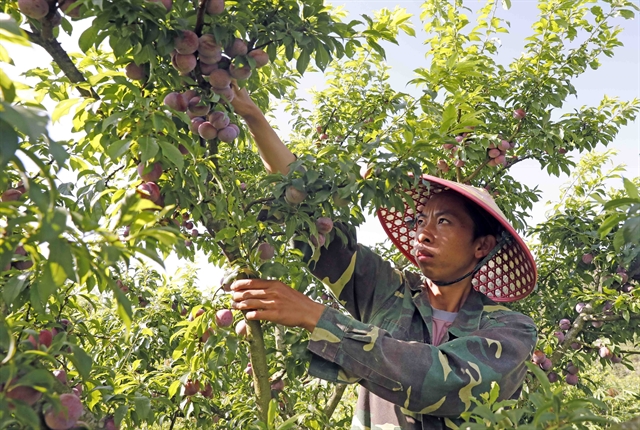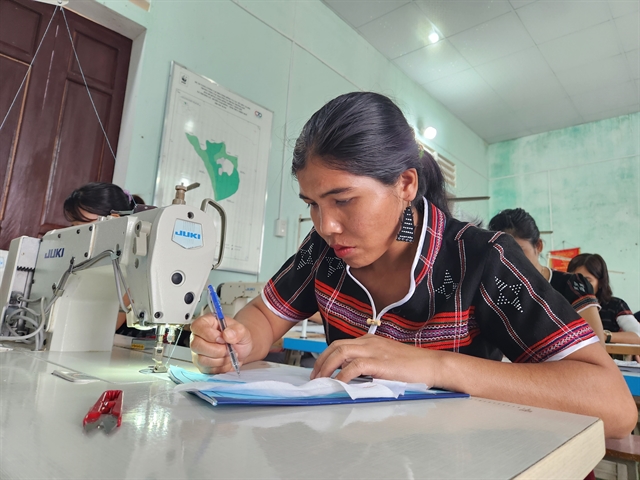 Society
Society

 |
| An ethnic Mông farmer harvests plums in his garden in Sơn La Province. — VNA/VNS Photo Trần Việt |
HÀ NỘI — Poverty reduction programmes and policies, especially in ethnic groups and mountainous areas, are gradually raising living standards for people, narrowing the gap between regions.
However, difficulties in poverty reduction are also present. Many districts still have a high poverty rate. The cycle of escaping poverty and then falling back into poverty is still an urgent issue, requiring early solutions to solve problems.
Achievements
Along with economic growth, the Party and State always put poverty reduction as a top priority.
That point of view has been shown in detail by priority resources for poverty reduction programmes.
In the 2016-20 period, the national poverty rate decreased from 9.88 per cent in 2015 to less than three per cent, making Việt Nam one of the first countries to reach the United Nations Millennium Development Goals on poverty reduction.
Last year, the multidimensional poverty rate decreased by 1.83 per cent, exceeding the target set by the 13th Party Congress’s Resolution.
The rate of poor ethnic households was reduced by 4.8 per cent.
Typically, in Sơn La Province, working models for the poor are integrated into high-tech agricultural development and organic agriculture.
It not only improves people's living standards, but also affirms that focusing on agricultural development is the right and effective direction of the province.
In Phiêng Khoài Commune in Yên Châu District, local people used to do farm work, and raise cattle and buffaloes.
Now, it is the centre for growing plums.
Plum trees are planted according to Vietnamese Good Agricultural Practices (VietGAP) standards for ripe fruits with a sweet taste and aroma.
They have helped local people escape poverty sustainably.
Tráng Lao Khai, head of the Lao Khô 1 Village in Phiêng Khoài Commune, said that the soil here was suitable for the plum trees, along with technical advances, so the trees had high yield and quality.
With over one hectare of plums, people can earn nearly VNĐ100 million per year (US$4,200). Many families have an income of VNĐ200-500 million ($8,400-21,000) per year.
Challenges
Many mountainous and border localities said that the first problem in poverty reduction is policy implementation.
The slow promulgation of guiding documents and capital allocation affects the work progress.
Funds for the programmes are not enough to meet the needs.
In addition, the quality of vocational training for ethnic youth was low.
Most of them cannot find a job after completing vocational training, or they have jobs, but enterprises have to re-train them.
The Ministry of Labour, Invalids and Social Affairs (MoLISA) said that many poor and near-poor households lack work, and have low and unstable incomes.
They also lack basic services such as housing, sanitation and information.
Bùi Sỹ Lợi, former deputy chairman of the National Assembly (NA)'s Committee for Social Affairs, said that preferential policies on land, tax and market support to attract businesses to invest in difficult areas and areas with ethnic groups had not brought the expected effect.
He said that it was necessary to re-evaluate programmes and policies to ensure social security for ethnic groups and mountainous areas in the 2011-20 period according to criteria such as policy appropriateness, beneficiaries, regional characteristics and localities’ enforcement capacity.
Will to escape poverty
 |
| Ethnic women join a vocational training class in Thừa Thiên-Huế province. — VNA/VNS Photo Mai Trang |
The National Target Programme on Sustainable Poverty Reduction in the 2021-25 period was approved by the NA in Resolution 24/2021/QH15 with a minimum capital of VNĐ75 trillion ($3.1 billion).
Chairwoman of the NA's Ethnic Council Y Thanh Hà Niê Kđăm said that the programme initially had certain effects by creating favourable conditions for poor and near-poor households to access effective production models.
Residents are supported with livestock and plants to develop production.
Education on poverty reduction has raised people's awareness. They have gradually changed their living habits and production methods and actively better themselves.
Deputy Minister of Labour, Invalids and Social Affairs Lê Văn Thanh said that to reduce poverty sustainably, policies must promote the will and internal strength of the people and the community.
He emphasised that the State should have policies to encourage enterprises to cooperate in the production and consumption of products, to develop a variety of models with the participation of poor and near-poor households.
Appropriate models need to be cared for and supported, especially in rural and mountainous areas.
Sustainability
Lộc Bình District in Lạng Sơn Province is promoting the National Target Programme for Sustainable Poverty Reduction and the Programme for Socio-Economic Development in Ethnic Group Areas.
The district sets a target by the end of this year to reduce the rate of poor households by three per cent or more.
Hoàng Hùng Cường, deputy chairman of the district People's Committee, said that the district was making efforts to limit re-falling back into poverty, especially in remote areas.
The district creates favourable conditions for the needy to access basic social services of health, education, housing, clean water, employment, and social assistance.
Developing the forest economy with new and effective models is one of the strengths for local people to escape poverty.
In Lạng Sơn Province, poverty reduction is implemented by the whole political system for sustainable results, said the provincial People’s Committee.
Many resolutions, programmes, plans and specific policies have been issued to promptly solve basic problems.
Therefore, the poverty rate in Lạng Sơn Province decreased from 25.95 per cent in 2016 to 5.76 per cent in 2021.
The poverty rate in impoverished districts decreased from 42.35 per cent in 2016 to 10.27 per cent in 2021, exceeding the target of reducing the poverty rate by four per cent per year.
Especially last year, the rate of poor ethnic households was 10.42 per cent of the total number of ethnic households, a decrease of 3.15 per cent compared to the previous year.
The Lạng Sơn Provincial People's Committee said that the National Target Programme on Sustainable Poverty Reduction this year in the province set a target that the poverty rate will decrease to 5.92 per cent by the end of the year.
To achieve that goal, the province will focus on supporting investment in socio-economic infrastructure in impoverished districts; developing poverty reduction models; improving nutrition; developing vocational education and decent jobs; and providing housing support for poor and near-poor households.
On the other hand, the province will closely link vocational education with job creation, income growth and quality of life enhancement.
It will well implement job counselling and introduction for rural workers, especially the poor; prioritise investment in schools and further training for teachers.
Localities encourage businesses to sponsor and accept the poor to work for their stable income. — VNS




